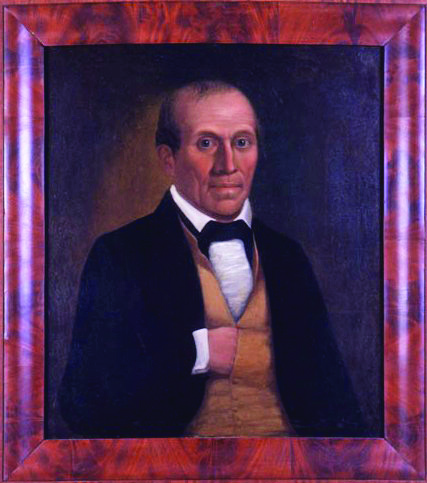

John A. McKinney, oil on canvas, at c. 1842 by Shaver is one of his earliest portraits. ("Great Road Style: The Decorative Arts Legacy of Southwest Virginia & Northeast Tennessee, Figure 149.)
Samuel Shaver was a prolific artist who painted over 100 known portraits of Tennesseans during his long career, which began as early as 1838 and continued through 1870. His ancestors were part of the German migration to America during the period just prior to mid-18th century. They ultimately settled in western North Carolina and moved from there to Abingdon, Virginia, around 1800. Samuel’s uncle, Michael Shaver, remained in Abingdon where he became a silversmith. His father, David Shaver, stayed in Abingdon for a short while before moving his family to Sullivan County near Kingsport, Tennessee. There, he built a log home some time after 1806, which he named Rock Ledge and where Samuel grew to adulthood.
Family history says that Samuel painted landscapes that hung over the mantel at Rock Ledge. In 1845, Samuel married Mary Hannah Elizabeth Powel of nearby Hawkins County. The daughter of Congressman Samuel Powel, Mary’s connections undoubtedly brought her husband many portrait commissions, including the one shown here titled “The Powel Boys.” Painted later in his career, it includes University of Tennessee buildings seen in the background.
The painting of John McKinney, the early owner of Rogersville’s McKinney Tavern - today Hale Springs Inn - is an example of Shaver’s early portraits that lack the addition of backgrounds, multiple figures and detail usually featured in his later work.
By 1856, Shaver was a widower and moved shortly thereafter to Knoxville, where he probably had a wider market for his commissions. He continued to paint portraits of political and business officials, as well as many families and children. At some point following his wife’s death, his mother-in-law moved to Illinois with his children and, by 1870, Samuel had followed them there. He continued his painting career in Illinois, listing his occupation as “portrait painter.” He died in Jerseyville, Illinois, in 1878.
This is the first in a new series of articles on Tennessee arts and antiques by Betsy K. White, director of William King Museum of Art, Abingdon, Virginia. She is the author of two books on the history of the region’s decorative arts and material culture: “Great Road Style: The Decorative Arts Legacy of Southwest Virginia & Northeast Tennessee” and “Backcountry Makers: An Artisan History of Southwest Virginia and Northeast Tennessee.”